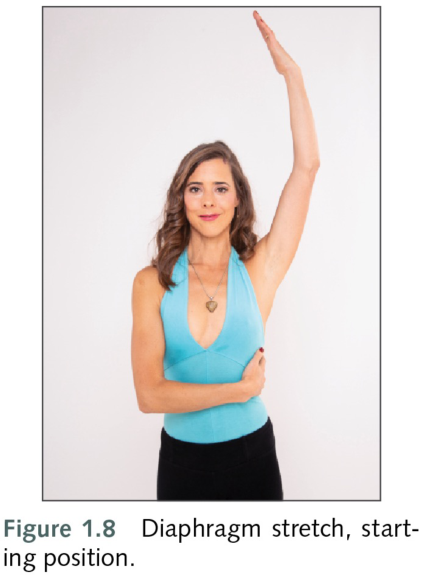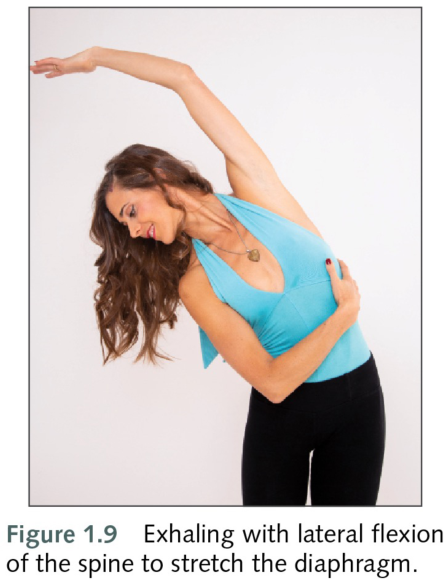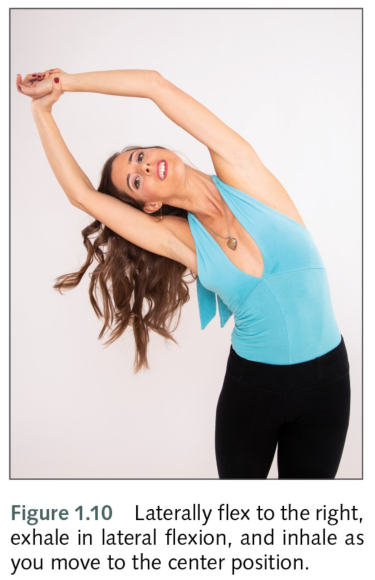Strengthening and Stretching Routine for the Diaphragm
This is an excerpt from Breathing for Peak Performance by Eric Franklin.
Stretching Your Diaphragm
The diaphragm needs its own designated stretching and strengthening routine, just like any other muscle. The diaphragm moves downward when you inhale, expanding the lungs and creating a vacuum. This vacuum causes air to rush into the lungs and oxygen to transfer through the thin walls of the lungs into the bloodstream. (For more information on the lungs, see chapter 2.)
What makes the diaphragm move downward? The diaphragm is a muscle, and muscles can shorten and lengthen between the origin and the insertion of the muscle. The origin is considered the fixed point, while the insertion is the part that is moved by the muscle.
If you want to stretch the diaphragm, you need to increase the distance between the origin and insertion, as in the following exercise. This exercise stretches other muscles, such as the intercostals (between the ribs) and the oblique abdominals, which in turn increases the benefit for the diaphragm.
- Stand in a comfortable position. You will begin by stretching the left side of the diaphragm. These fibers are mostly located between the 12th rib and the central tendon along the inside of the rib cage, which is called the zone of opposition. Lift your left arm over your head, and place your right hand on your lower ribs on the left side (figure 1.8).

- As you exhale, laterally flex your spine to the right (figure 1.9). Two factors are causing the diaphragm to lengthen as you perform this movement—the fact that you are exhaling, and the increase in distance between the 12th rib and the top of the diaphragm.

- Inhale as you return to the upright position. Repeat the movement for five breath cycles. Exhale as you move to the right; inhale as you return to the upright position.
- Imagine the muscle fibers of the diaphragm lengthening underneath your ribs. To increase the stretch, gently push down on the left lower ribs (7-12) with your right hand.
- Return your left arm to the side of the body and rest for a moment. Notice any differences between the two sides of the body. The entire right side of your body may feel more relaxed. Imagine breathing into your right lung, then your left lung. Does it feel as if your right lung takes in much more air than the left? That is because the right hemisphere got stretched and is more flexible, allowing for more movement of the diaphragm and ribs.
- Perform the same exercise on the other side. Lift your right arm up above your head, place your left hand on the right side of the rib cage, and flex your spine to the left while exhaling. Repeat the movement for five cycles of breath. As you move to the left, exhale; as you return to the upright position, inhale.
- To finish the exercise, reach up with both arms and clasp your hands. Laterally flex your spine to the right and left (figure 1.10). During lateral flexion, exhale; when you return to center, inhale. Move to the right and left four times.

- Drop your arms down to your sides, and rest in the standing position for a moment. You may notice that your posture has improved, your lungs feel as though they are lifting you upward like balloons, and your sternum is higher. Working with your breath is good for your posture and general sense of well-being.
- Be aware of the stretch of the diaphragm when you exercise. Notice how movement of the thorax and spine affect the length of the fibers of the diaphragm. Use this awareness to increase the stretching of your diaphragm, even when you are focusing also on other aspects of the exercise.
SHOP

Get the latest insights with regular newsletters, plus periodic product information and special insider offers.
JOIN NOW
Latest Posts
- Outdoor recreation and adventure activities lead to positive health outcomes for children
- Schools offer a wide variety of adventure programs for children
- Using sport to change society
- Despite progress, equity remains a pressing challenge for women in sport
- What today’s athletes expect from coaches
- Barriers to youth participation in physical activity and sport


